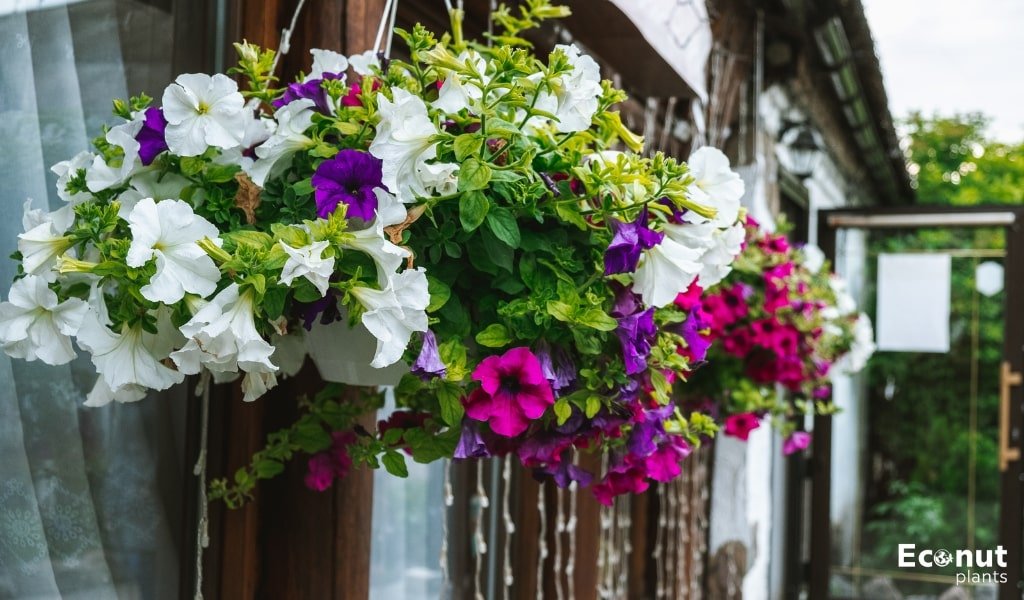Petunia Hanging Baskets are the most popular summer flower because of their trailing, spreading, or mounding habit, vibrant, long-lasting flowers, and quick growth.
Petunias are a great option to plant in hanging baskets if you’re unsure what to put in them. Uncertain of the best way to maintain their health for the longest? Best advice for this season’s basket-bound petunias, with an emphasis on longer-lasting and better blooms!
Choose the Right Varieties
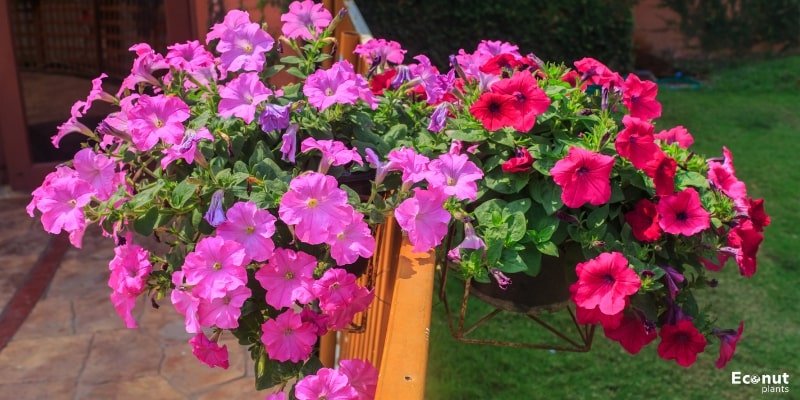
There are petunia kinds that thrive in hanging baskets more than any other place, given the abundance of selections available. Petunias that are confined to baskets can greatly benefit from wave and supertunia kinds. In the long term, they will be well worth the slight increase in cost.
Supertunia and wave types don’t need to have their wasted blooms removed during the season because they are self-cleaning plants. This is fantastic since it eliminates the need to reach up and remove the basket from the hook to clean the spent blooms.
These cultivars typically trail over the basket’s edge, which is a popularly desired appearance. The length of these might range from 24 to 48 inches, depending on the variation you select. Mounding types do grow well in baskets as well; they just won’t overflow the sides as much.
Pick a Larger Hanging Container
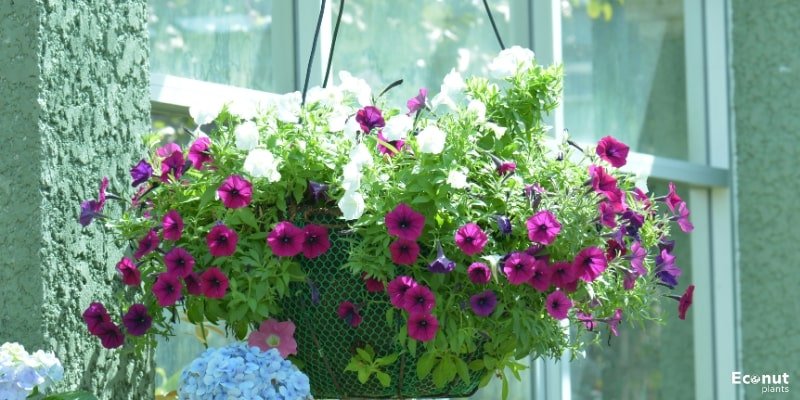
There are a few things to remember, whether you bought a hanging basket of petunias from a garden center or you chose to buy an empty basket to fill with petunias. To start, make sure your basket has adequate space for your plants to grow. Petunias are usually kept in a suitable container by garden centers during the summer.
All you’ll need to do is have fewer plants growing in each basket; you can have smaller ones. If you can’t find any hanging baskets in your area that match the style of your garden, you can also create your own.
The container’s appropriate drainage holes must then be checked. Petunias prefer well-draining soils; therefore, this is quite important. As an alternative to plastic, you may use a basket lined with cocoa. To prevent damp soils for extended periods, you need good drainage, regardless of the basket you select.
Use the Right Soil
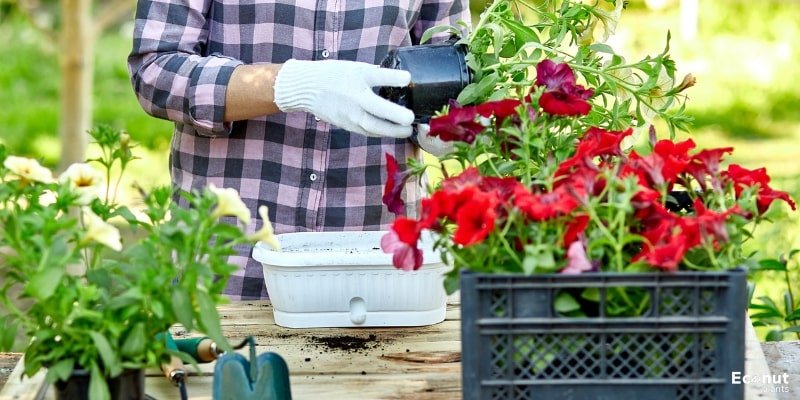
Successful petunias start with healthy soil. Petunias prefer soils that have plenty of organic content and good drainage. If you bought your basket from a garden center, the soil they use is usually good potting soil with lots of organic matter to promote healthy development.
Excellent potting soils for plants in hanging baskets are available at nearby garden centers and nurseries if you’d like to purchase your own. To prevent it from getting overly compacted over time, just make sure the soil is light and fluffy.
Provide Adequate Sunlight
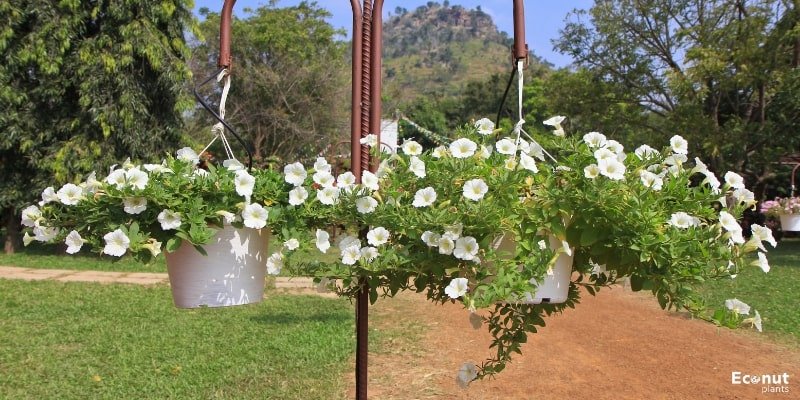
Since petunias revere the sun, they require at least six hours of sunshine each day to survive. The ideal way to plant petunias is to expose them to at least eight hours of sunlight. It’s not always easy to choose a spot for your basket that gets enough sunshine.
To ensure that flower gardens and landscapes receive full sunshine, hanging baskets can be suspended from hooks in the middle of the beds. That being said, petunias are frequently draped from roofs, patio covers, and overhangs. Examine the space where you intend to hang your baskets to be sure that nothing is blocking the light.
Water More Frequently
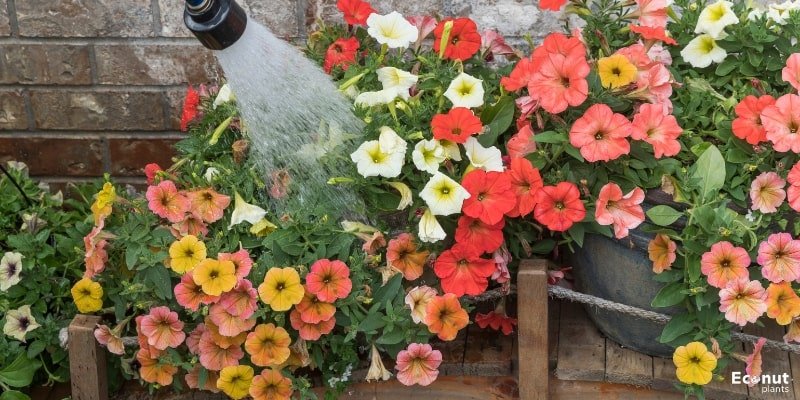
Generally speaking, hanging baskets need more frequent watering than a regular garden. Because they are shallow, they often dry out rapidly, especially on hot, windy days. To determine whether your baskets want water and are receiving the right amount, there are a few techniques you can use.
Checking the soil is another option after removing the basket from its hook. In hanging baskets with petunias, never allow standing water or excessively wet soils to grow.
Petunias can withstand some drought, but only if deep roots are encouraged. Because there is little room for roots to spread out in an enclosed area, this is more challenging to accomplish. If you leave your petunias in a dry basket for longer than a day or two, they may start to suffer.
Fertilize as Needed
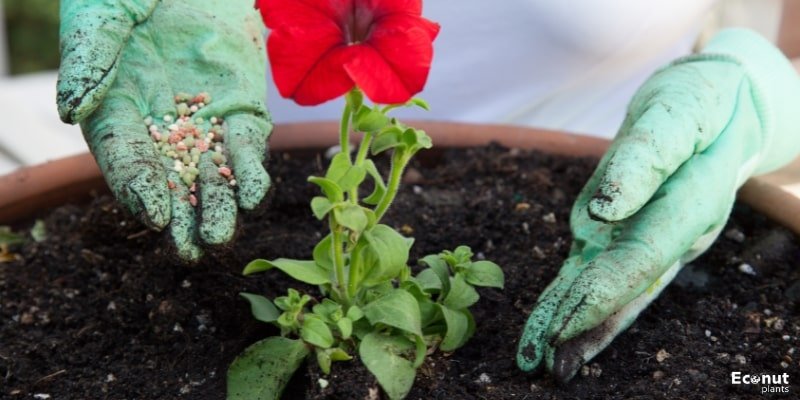
Petunias have a ravenous appetite, so the nutrients in the soil around them can be rapidly consumed. You can start fertilizing your hanging baskets as soon as you plant them or get them home. The benefit of slow-release fertilizers is that they release nutrients into the soil progressively over a few weeks.
Even though frequent watering may cause liquid fertilizer to seep out of the soil, it still functions as intended. Furthermore, leaves treated with liquid fertilizer may burn and become unattractive. Make sure you apply liquid fertilizer every two weeks to avoid nutrient loss.
Also Read: Growing Petunias from Seed
Prune and Deadhead When Necessary
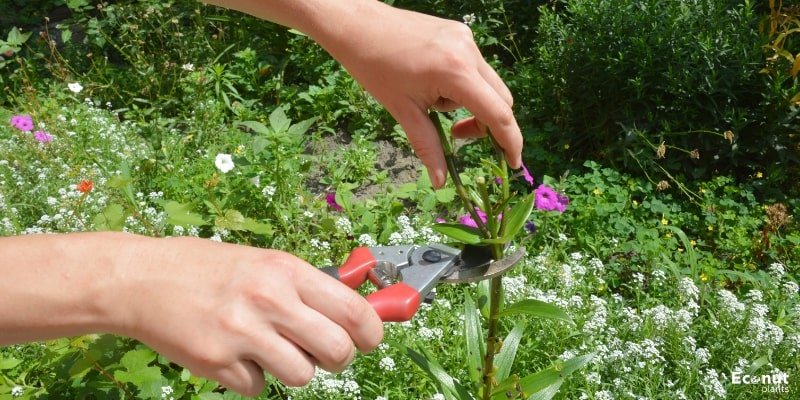
Not every petunia will require season-long pruning and deadheading. Wave and supertunia petunias shed their spent blooms and are self-cleaning, as I previously said.
You might need to deadhead your petunias to keep them looking tidy and healthy if you decide to cultivate different kinds that aren’t self-cleaning.
All petunias can have their lanky stems pruned at some point during the season. Stunky stems are unsightly and produce few flowers or leaves. If you think a stem is getting too long or scraggly, cut it back. This will encourage a petunia that is shorter, fuller and produces more blooms.
Don’t Crowd the Basket
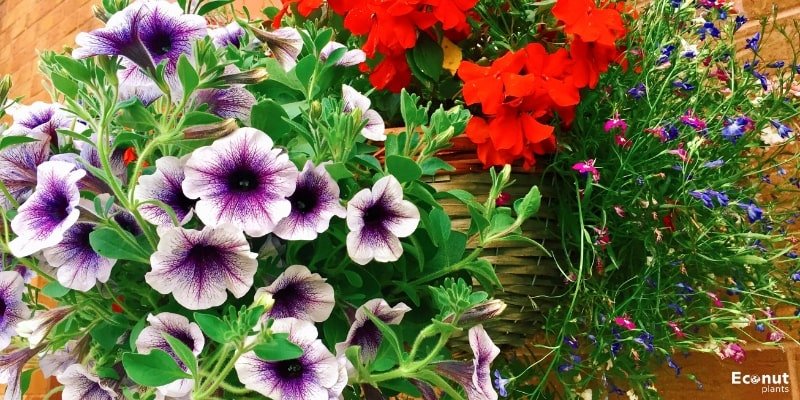
When they get bigger, having too many plants in one area can lead to a lot of problems. As a general rule of thumb, divide the container’s size by two.
For instance, you should plant a total of six plants if your basket is 12 inches in diameter. Alternatively, you might plant up to 10 plants in total if you have a 20-inch basket.
This guideline also applies to any plants you want to grow, in addition to mounding petunias. Petunias that spread, like wave and supertunia, may require a little more space if you decide to cultivate them.
One spreading petunia type can be planted for every three inches of basket. For instance, you can plant a total of four spreading petunia kinds in a 12-inch basket.
Pick a Sheltered Location
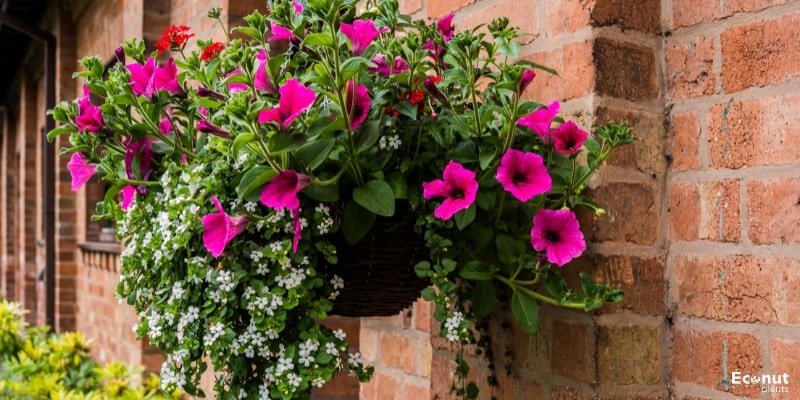
Hanging baskets are somewhat exposed, particularly in severe weather conditions. To ensure that your plant survives the entire season, make sure the location you select offers some protection from wind, severe rain, and hail.
Due to their delicate nature, petunias are susceptible to damage from hail, severe rain, and strong winds. Petunias are already delicate, but hanging baskets can also topple over if not adequately supported. Consider putting them on the ground until the weather clears up if your area is predicted to experience severe weather or windy conditions.
Add Some Companions
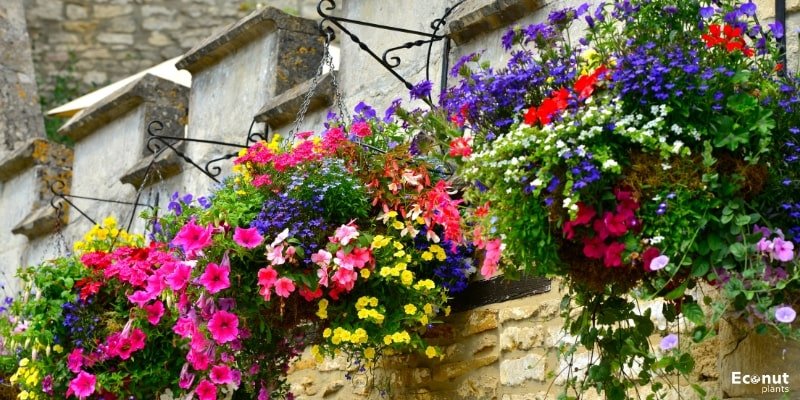
Yes, petunias by themselves look wonderful in hanging baskets. But in arrangements for container gardening, they also look fantastic with companion plants. When it comes to planting basket arrangements with different plants, there are countless alternatives available. Remind yourself not to throng.
Common plants that thrive in baskets with petunias are sweet potato vines, geraniums, creeping Jenny, and calibrachoa. Take care that the plant you select doesn’t grow too tall or too short to be visible in the basket.
Treat Problems Immediately
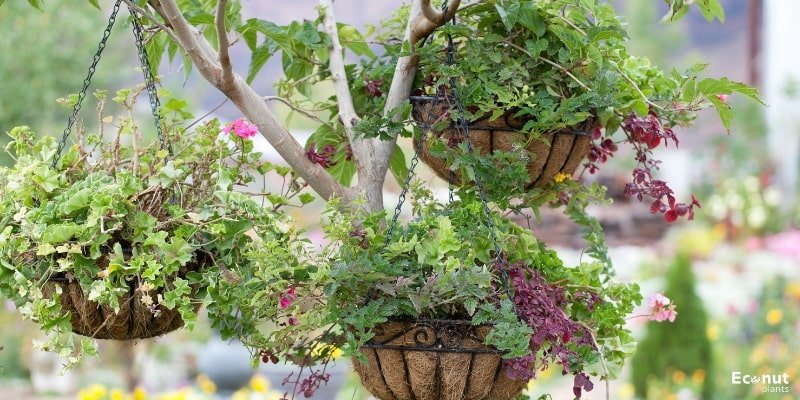
Petunias are typically easy-going and rarely suffer from illnesses or pest problems. That does not imply that your petunias are risk-free. Sometimes pests and diseases get onto petunias and can’t do much harm if they’re not dealt with right away.
To promptly detect pests and illness, check your baskets frequently. Removing contaminated stems leaves, and blossoms from the hanging baskets will help you easily control both. Fungicides and insecticides can be useful if pests and illnesses are too advanced, but your pets may perish from the damage.
Conclusion
Petunias, one of the most well-liked plants to grow in hanging baskets, will bloom continuously throughout the season in a vibrant display of colours. They will repay you with a stunning display of flowers and foliage with a little bit of maintenance.
You can’t go wrong with any option, whether you decide to plant a whole hanging basket of petunias or combine them with companion plants to create a unique piece.

